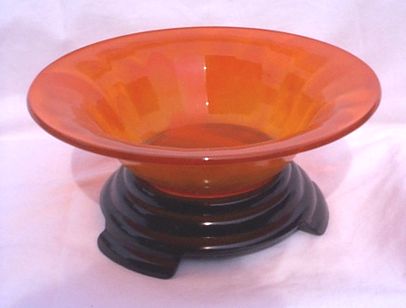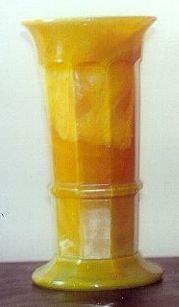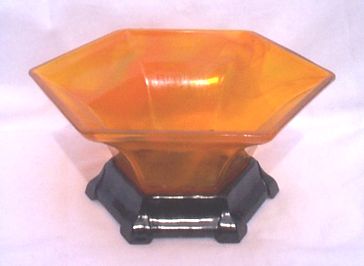|
|
||||||||||||||||||||||
|
||||||||||||||||||||||

“...We also noticed that the orange cloud has been subjected to some modifications, and in its new guise this appeared to be in great demand for the export trade.”
 The picture, left, shows the original
orange colour. The base glass is a pale orange and the trails
are almost yellow, like custard. Indeed the trails can be such a
colour that they are mistaken for the non-existent yellow Cloud Glass. If
the trails are strong near the rim or edge of a vase, they have an almost
pearline look to them. The picture, left, shows the original
orange colour. The base glass is a pale orange and the trails
are almost yellow, like custard. Indeed the trails can be such a
colour that they are mistaken for the non-existent yellow Cloud Glass. If
the trails are strong near the rim or edge of a vase, they have an almost
pearline look to them.
|
 The
picture, right, shows the second form of orange. Again the base colour is
a pale orange, but now the trails are a deeper orange and completely
different from the previous example. On heavily trailed pieces, the orange
has a distinct reddish tinge. The
picture, right, shows the second form of orange. Again the base colour is
a pale orange, but now the trails are a deeper orange and completely
different from the previous example. On heavily trailed pieces, the orange
has a distinct reddish tinge.
|
The first trial run of Orange Cloud Glass was made on the 23rd January 1933 when 1910M and 1910MD bowls were made, none of which passed inspection. The next attempted production run was on the 14th February 1933 when No 20 bowls, 712 8" vases and 696 F, C and D flower bowls were made in a 'New Colour'. A second attempt was made on the following day when No. 279 6 and 8 inch vases, No. 279 D 10 inch vases, No. 51 vases, 283 6" jars and 732 and 732F bowls were made. The comment on the production run was 'All Blistery Metal'. The glassmaker, Graham, was paid £1 for these two days work. An entry in the index for the next account book which started on the next day, 16th February, confirms that this new colour was Orange Cloud Glass.
The next attempted production run was made on 20th March 1933. The glassmaker, Graham, made 55 8” No 712 vases. These were all described as ‘Bad Colour’ and rejected. On the following day the same glassmaker made 712 vases and the full range of 279 (column) vases. The result this time was ‘Bad Shapes’ and ‘Seedy Metal’. Seedy Metal means the glass contained lots of small bubbles. Despite this most of the production run was passed by the inspectors. On the 24 and 25th March the glassmaker George Hall made a large number of different styles of bowls in Orange, including patterns 701, 702, 727, 21, 20, 732, 248, and 696. This time the shape of the glass was fine, but they still had the problem of seedy metal.
Normally glassmakers were paid for each item they made which passed inspection. The amount paid depended on the complexity of the design. Higher rates were paid for Cloud Glass than ordinary flint or coloured glass. As they were having so many problems with the Orange the glassmakers were paid a flat hourly rate, rather than per item.
After the 25th March they went back to the drawing board and no more Orange Cloud Glass was made until the 8th May. On this day the glassmaker Graham made 712 and 279 vases and 732 Flower Bowls. This run was more successful, with the records having no comments about seedy metal. Over the next five days, a large range of vases and bowls were made. Only a few had the seedy metal problem. Again there was a break in production until July, when on the 11th Orange Cloud Glass was once again made. This production run ended on the 26th July.
The manufacture of Orange Cloud Glass did not resume until the 7th December that year. It would appear that this was the first production run of the modified form of Orange Cloud Glass. After the 20th December, no more Orange was made until March 1934. As the modified form of Orange was first shown in the February 1934 British Industries fair, this glass had to have been made in the December.
Large quantities of Orange Cloud Glass were made in March, April, May and June of that year. There then followed a short break and production resumed at the end of August. This run was short lived, Orange Cloud Glass was made on only 6 days in late August and Early September. No more was made until April 1935. Again large quantities were made in April, May and June of that year.
This is an unusual production schedule. For all other types of glassware, the production was constant through out the year. Typically a particular colour would be made over a period of one or two days followed by a gap of a few days or even a few weeks. The Orange Cloud Glass production schedule could have been the result of trying to keep shipping costs down. They produced the glass and then shipped the bulk of the production run to Australia in a single shipment.
After June 1935, there was again a break in production until the 10th December. The very last production run was on the 13Th December that year. In this final run they made the 204 and 204D posy bowls – the only time this style was made in orange Cloud Glass.
 Orange
Cloud Glass caused Davidson many problems. It was both difficult and expensive
to produced. As a colour, it was not popular at home and the bulk of
production went abroad. The short
life of the colour suggests that its popularity abroad was not great. In the
records there is also no mention of a Yellow Cloud Glass. This suggests that
yellow results from times when they had problems obtaining a good orange
colour and probably sold as ‘seconds’.
Orange
Cloud Glass caused Davidson many problems. It was both difficult and expensive
to produced. As a colour, it was not popular at home and the bulk of
production went abroad. The short
life of the colour suggests that its popularity abroad was not great. In the
records there is also no mention of a Yellow Cloud Glass. This suggests that
yellow results from times when they had problems obtaining a good orange
colour and probably sold as ‘seconds’.
Fortunately for collectors some of the Davidson records survive. From these we have been able to produce a complete catalogue of Orange Cloud Glass. The table below shows the total number of items made in Orange Cloud Glass for each style. The table includes both the number of items made, and the number of items that passed inspection. The problems with orange meant that the wastage rate with Orange Cloud Glass was higher than any other colour. The information in the table was obtained from surviving glassmaker records. These show what the glassmaker made and how much he was paid (it was an all male profession at the time). There are some errors in the records. For example according to the accounts only 7.5” 204 posy bowls were made in orange, yet 9” ones are known to exist. In other places the No 10 Grid fitting is described as an ashtray! The fact that a wrong style was written down did not concern the glassmaker, providing he was paid the correct amount. On the whole the records are accurate.
Davidson Office staff often were not consistent as to whether a style was classified as either a bowl or a vase. In this table we have followed Davidson’s records and some flower bowls are included under the Vase list. The column headed Colour Variant shows whether a design was made in Unmodified Orange, Modified Orange or both.
| Davidson Pattern No | Number Made | Number which Passed Inspection | Colour Variant (Modified, Unmodified or Both) | Comments |
| Ashtrays: | ||||
| 27 | 1242 | 1088 | ||
| 29 Hearts | 854 | 802 | Both | |
| 30 Spades | 816 | 756 | Both | |
| 31 Diamonds | 898 | 850 | Both | |
| 32 Clubs | 845 | 802 | Both | |
| Candlesticks: | ||||
| 283 S | 8140 | 7320 | Both | |
| Cigarette Box | ||||
| 1 | 437 | 348 | Modified | |
| Lid for No 1 | 600 | 455 | Modified | |
| 2 | 570 | 504 | Modified | |
| Lid for No 2 | 818 | 754 | Modified | |
| Dishes: | ||||
| 283 3" | 1450 | 1369 | Both | |
| 283 Salad 8.5" | 133 | 59 | Modified | |
| 26 9" | 25 | 10 | Unmodified | |
| 27 Boat shaped | 840 | 622 | Both | |
| 12 Hearts | 50 | 36 | Unmodified | Only one batch made |
| 13 Spades | 50 | 37 | Unmodified | Only one batch made |
| 14 Diamonds | 50 | 38 | Unmodified | Only one batch made |
| 15 Clubs | 50 | 36 | Unmodified | Only one batch made |
| Flower Blocks: | ||||
| 3H 2.5" | 100 | 96 | Modified | Only one batch made |
| 3H 3.5" | 100 | 96 | Modified | Only one batch made |
| 3H 4" | 110 | 107 | Modified | |
| 3H 4.5" | 50 | 49 | Modified | Only one batch made |
| 3H 5" | 63 | 51 | Both | |
| 8 2.5" | 100 | 100 | Modified | Only one batch made |
| 8 3" | 50 | 46 | Modified | Only one batch made |
| Flower Bowls: | ||||
| 20 | 976 | 862 | Both | |
| 21 | 2023 | 1586 | Both | |
| 24 | 778 | 728 | Both | |
| 24M | 1690 | 1613 | Both | |
| 25 | 200 | 193 | Unmodified | |
| 696C | 433 | 403 | Both | |
| 696D | 512 | 497 | Both | |
| 696F | 520 | 390 | Both | |
| S/696D | 1067 | 974 | Both | |
| S/696F | 1294 | 1083 | Both | |
| 699D | 95 | 87 | Both | |
| 699F | 23 | 17 | Unmodified | Only one batch made |
| 700D | 694 | 529 | Unmodified | |
| 732 | 2372 | 1928 | Both | |
| 732F | 2098 | 1486 | Both | |
| 1907T | 794 | 702 | Both | |
| 1907TD | 1695 | 1611 | Both | |
| 1910BD | 2961 | 2661 | Both | |
| 1910BF | 8 | 4 | Unmodified | Only one batch made |
| 10/1910 | 480 | 434 | Modified | Only one batch made |
| 1910D | 130 | 105 | Modified | Only one batch made |
| 1910M | 87 | 85 | Modified | Only one batch made |
| 1910MD | 834 | 805 | Modified | |
| 1910MG | 221 | 186 | Modified | |
| 1910SD | 1580 | 1494 | Modified | |
| 248F | 1940 | 1735 | Both | |
| 248D | 1932 | 1791 | Both | |
| Grid Support: | ||||
| 10 4.5" | 80 | 80 | Modified | All Bad Colour, Only one batch made |
| Powder Jars: | ||||
| 283 3" | 1240 | 1204 | Both | |
| 283 5" | 1188 | 906 | Both | |
| Posy Bowls: | ||||
| 204 7.5" Optic | 141 | 127 | Modified | 9" Bowls known to exist. Only one batch made |
| 204D 7.5" Optic | 53 | 49 | Modified | Only one batch made |
| Plinths: | ||||
| 1 | 120 | 119 | Modified | |
| 2 | 60 | 56 | Modified | Only one batch made |
| 3 | 200 | 195 | Modified | |
| 4 | 150 | 135 | Modified | |
| 248 | 200 | 195 | Modified | |
| 24 | 55 | 38 | Modified | Only one batch made |
| 24M | 155 | 140 | Modified | |
| Plates: | ||||
| 280 Square | 610 | 469 | Modified | |
| Trinket Trays: | ||||
| 5P (Plain) | 794 | 722 | Both | |
| Vases: | ||||
| 1 | 120 | 92 | Modified | Only one batch made |
| 34 D | 31 | 29 | Modified | Only one batch made |
| 34 SD | 281 | 274 | Modified | |
| 34 SLF | 130 | 111 | Modified | |
| 34 VF | 50 | 47 | Modified | Only one batch made |
| 34 SVG | 150 | 147 | Modified | |
| 34 VG | 50 | 49 | Modified | Only one batch made |
| 34 SVF | 160 | 159 | Modified | 109 wrong colour |
| 34 SF | 30 | 29 | Modified | Only one batch made |
| 50 | 109 | 90 | Modified | Only one batch made |
| 51 | 488 | 434 | Unmodified | |
| 279 6" | 1264 | 1109 | Both | |
| 279 D 6" | 72 | 60 | Both | |
| 279 8" | 1141 | 995 | Both | |
| 279 D 8" | 136 | 108 | Both | |
| 279 10" | 709 | 579 | Both | |
| 279 D 10" | 160 | 115 | Both | |
| 292 | 57 | 57 | Modified | Only one batch made |
| 293 | 100 | 89 | Modified | Only one batch made |
| 294 | 100 | 99 | Unmodified | Only one batch made |
| 701 | 57 | 42 | Both | |
| 702 | 62 | 45 | Both | |
| 703 | 59 | 47 | Both | |
| 705 | 130 | 101 | Both | |
| 707 | 133 | 104 | Both | |
| 712 8" | 1167 | 1025 | Both | |
| 712C 8" | 5 | 5 | Modified | Only one batch made |
| 712D 8" | 37 | 36 | Modified | Only one batch made |
| 712 10" | 369 | 310 | Both | |
| 721 | 194 | 164 | Both | |
| 722 | 161 | 149 | Both | |
| 723 | 388 | 332 | Both | |
| 725 | 337 | 320 | Both | |
| 726 | 6 | 4 | Modified | Only one batch made |
| 727 | 787 | 544 | Both |
Flower sets in Orange normally have a black stand and flower block. Orange flower blocks and stands were made, but are extremely rare - as can be seen from the table above. The contrast of black on orange was presumably more popular with the buying public. Orange Cloud Glass normally comes with polished upper and lower surfaces.
In the 1960s Davidson attempted to revise some of it's earlier designs. A malachite or slag glass was produced which mixed orange, yellow and white.

|
|
|
|